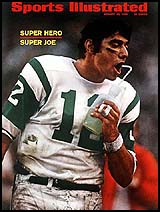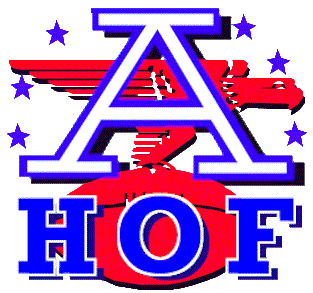|
|
|||||
|
|
|
|
|||
| . | |||||
EVENTS CENTERS CNNSI.com GROUP COMMERCE |
The AFL: A Football Legacy Off-the-field competition yields game-changing mergerPosted: Monday January 22, 2001 2:57 PM
The American Football League kicked off Sept. 9, 1960, as Denver defeated Boston 13-10. During the following decade, the AFL challenged the National Football League for professional gridiron supremacy, eventually prompting a merger that led to the current 31-team NFL. In preparation for the 35th edition of the AFL's most notable achievement -- the Super Bowl -- join us in a fond look at the watershed moments in a league born from one man's simple desire to own a football team. Part 2 of a two-part series By B. Duane Cross, CNNSI.com The American Football League survived its 1960-64 incubation period with high expectations. But not even trailblazers Lamar Hunt of Kansas City and Bud Adams of Houston could fathom what lay on the horizon. NBC began televising league games in 1965, the result of a five-year, $36 million deal. It was the beginning of the end of the AFL; the financial muscle now wielded by the league ultimately led to the AFL-NFL merger. Also in 1965, New York Jets owner Sonny Werblin signed University of Alabama quarterback Joe Namath to a stunning $427,000 contract. It was the league's most high-profile signing since Adams' Oilers signed Heisman Trophy winner Billy Cannon ($100,000) in '60. In his autobiography Butkus: Flesh and Blood, former Chicago Bears linebacker Dick Butkus recalls the bidding war between the AFL and NFL. Denver scout Red Miller, who would later become the Broncos' head coach, approached Butkus after his final regular-season college game and said Denver was interested in signing the Illinois star. Miller said the Broncos' owners -- the Phipps brothers -- were intent on bringing defense with a capital D to the free-wheeling, pass-happy AFL. After word leaked to the media, Butkus remembers, "mere buckets" of money became "wheelbarrows." Merger talks beginDallas president-general manager Tex Schramm says, "After the 1965 season, I was convinced the structure of pro football was in trouble. Teams in both leagues were no longer drafting the best players. The draft became predicated on which players you could sign." In fact, AFL teams were so certain Heisman Trophy winner Mike Garrett would sign with the NFL's Los Angeles Rams that none bothered to draft him until Kansas City in the 20th round. Garrett signed with the Chiefs. Joe Foss, a former two-term governor of South Dakota, stepped down as AFL commissioner in 1966. Al Davis, general manager and head coach of the Oakland Raiders, replaced him April 8. "I guess they [AFL owners] thought I'd be a catalyst," says Davis. "It was a situation that called for some constant pressure to be put on the other side." "Joe Foss was the perfect image guy for the AFL in the early years," says Jerry Magee, a sportswriter for the San Diego Union-Tribune. "He was a folksy kind of guy." However, by the mid-1960s, the AFL was primed to challenge the NFL for gridiron supremacy. And the AFL's new maverick commissioner fired the first volley. Davis immediately began stepping up the bidding war, raiding the NFL for players.
"When Davis took over, clubs started signing up some of the NFL's talent," says Magee. "The rationale was the AFL signings were a way to get back at the NFL for the Pete Gogolak signing. [Davis] was the master of guerilla warfare." Gogolak, professional football's first soccer-style kicker, jumped ship from Buffalo in the AFL to the NFL's New York Giants. In retaliation for the Gogolak signing, Adams offered San Francisco 49ers quarterback John Brodie a 10-year, $750,000 contract. The Oilers also signed tight end Mike Ditka, and Oakland signed Rams QB Roman Gabriel with a reported $100,000 down payment. None of the players ever suited up for their AFL suitors. "Al Davis taking over as commissioner was the strongest thing the AFL ever did," remembers Magee. "He thought the peace [AFL-NFL merger] was a detriment to the AFL because they had to pay reparations to the 49ers and Giants." Two months after Davis took the league's reins, the AFL and NFL agreed to an alliance that included a common draft, championship game and a complete merger by 1970. On May 31, 1966, Schramm and Kansas City Chiefs owner Lamar Hunt hammered out the framework for the merger, which was announced June 8. Included in the merger was an $18 million indemnity to be paid by the AFL to the NFL over 20 years. Under the merger agreement, NFL commissioner Pete Rozelle would oversee both leagues. "Davis was the man who would be king," says Magee. "It was a disappointment to him that they merged." Davis stepped down as AFL commissioner on July 25, 1966, rejoining the Raiders as managing general partner. Milt Woodard was named president of the league. On Sept. 2, 1966, the Miami Dolphins, the first expansion franchise in AFL history with Minneapolis attorney Joe Robbie and entertainer Danny Thomas as partners, made a splash in their inaugural game. Joe Auer returned the opening kickoff 95 yards for the team's first touchdown. Nonetheless, the Dolphins were defeated 23-14 by Oakland. Off to a Super startFollowing the 1966 season, Kansas City and Green Bay played in the AFL-NFL World Championship Game (Super Bowl I). Vince Lombardi's Packers downed the Hank Stram-led Chiefs 35-10 at Memorial Coliseum in Los Angeles. "Super Bowl I was the true war of the world," says Magee. "This year will be my 33rd Super Bowl, and a lot of them run together. But I remember everything about Super Bowl I. "My most vivid memory is of the morning of the game. It was very foggy and players were standing around the bus, hugging their wives, like guys going to war. In effect they were." Stram, whose Chiefs would win Super Bowl IV against Minnesota -- the final title game before the merger took effect in 1970 -- was a linchpin for the AFL. "He was a good guy for the league," says Magee. "He was a very good PR guy and a good coach. "The AFL introduced a lot of new things to pro football. They played zone football. Stram did a lot of things, such as the floating pocket." The first AFL-NFL draft occurred in 1967. The Baltimore Colts traded with New Orleans for the overall No. 1 choice and selected Michigan Sate defensive end Bubba Smith.
The AFL's most impressive individual accomplishment in 1967 came from Namath. He passed for a record 4,007 yards and 26 touchdowns. Green Bay also won Super Bowl II, a 33-14 victory over Oakland at the Orange Bowl in Miami. It was Lombardi's final game as head coach of the Packers. The 1968 season may have brought the two most famous AFL games -- both involving the Jets. On Nov. 17, Oakland defeated New York 43-32 in the "Heidi Game." The Raiders trailed 32-29 with 65 second remaining in the fourth quarter, and NBC switched from the game (except areas west of Denver) to the children's classic. What fans -- including more than 10,000 callers to NBC's switchboard in New York -- missed was a 43-yard touchdown pass from Raiders QB Daryle Lamonica to Charlie Smith and a 2-yard fumble return by Preston Ridlehuber on the ensuing kickoff. On Jan. 12, 1969, the investment in Namath paid off for New York. The Jets stunned the heavily favored Baltimore Colts 16-7 in Super Bowl III. Three days before the game, Namath told an audience at a Miami Touchdown Club dinner: "We're going to win Sunday, I'll guarantee you." Ironically, it wasn't the strong-armed Namath who was most responsible for the victory, though he was named MVP (17 of 28 passing for 206 yards). Jets running back Matt Snell rushed for 121 yards and New York's only touchdown and Jim Turner kicked three field goals. "This was a victory not just by the Jets," recalls Magee, "but the whole league. [The Jets] substantiated the league. I know everybody in the AFL felt that way." Be sure to see the link to Part I of this story, at the bottom of this article.
Information for this series was culled from Internet sites, Football Digest, 25 Years: The NFL Since 1960, Butkus: Flesh and Blood, NFL Record and Fact Book and league media guides. |
|||||||||||||||||||||||||||||||||||||||||||||||||||||||||||||||||||||||||||||||||||||||||||||
|
|
||||||||||||||||||||||||||||||||||||||||||||||||||||||||||||||||||||||||||||||||||||||||||||||





